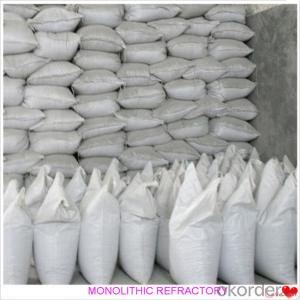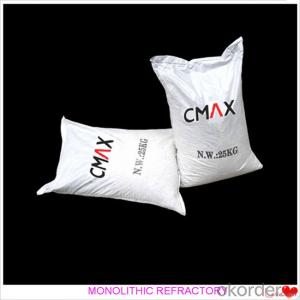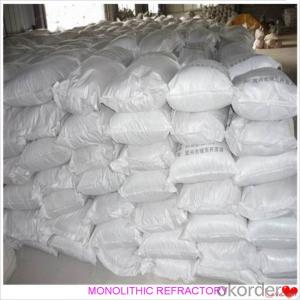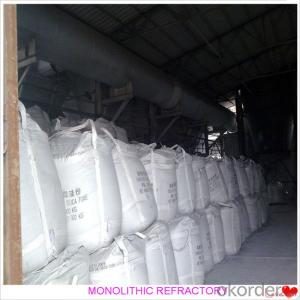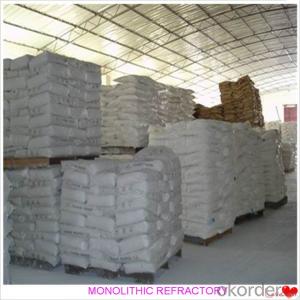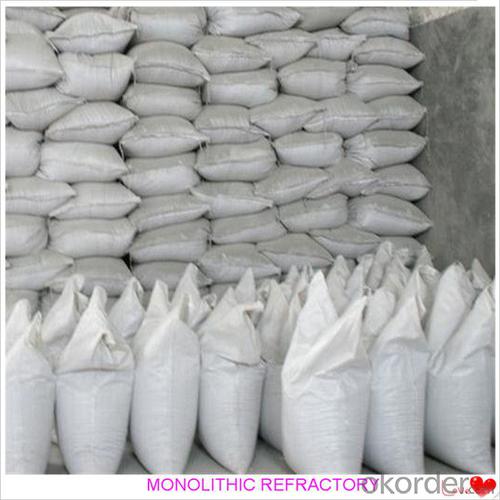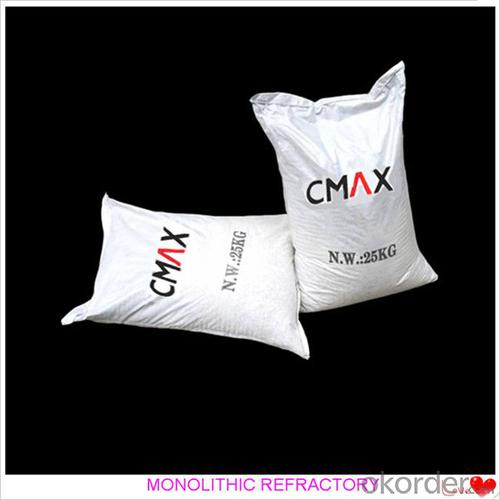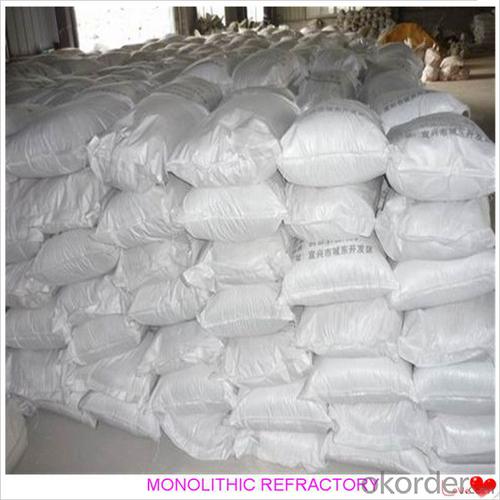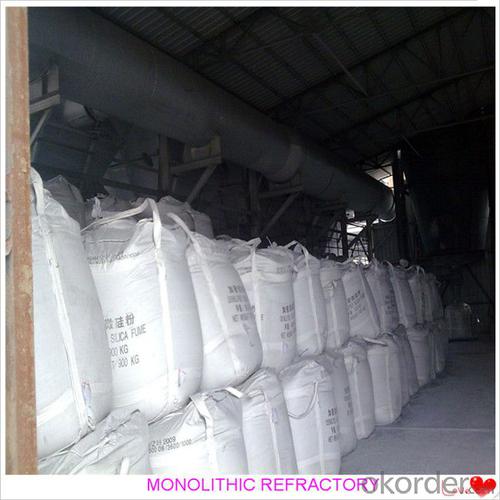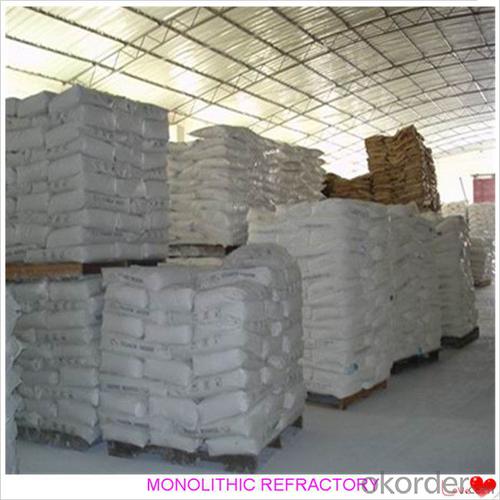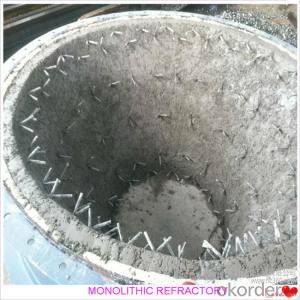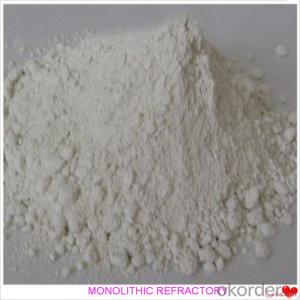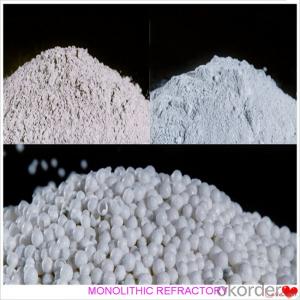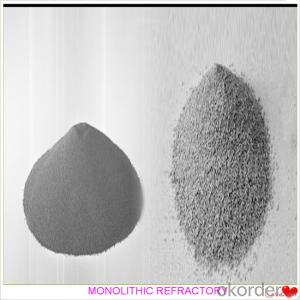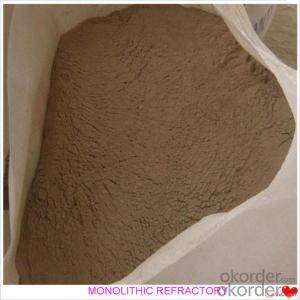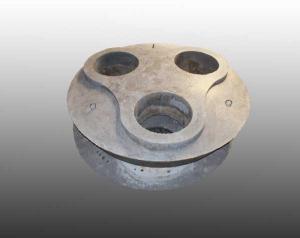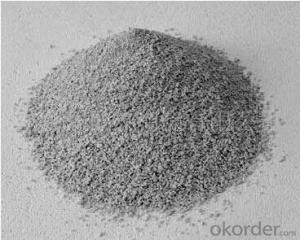Monolithic Refractories for Iron and Steel Industry - Fireclay Castable for Fireplace and Industrial Furnace
- Loading Port:
- China main port
- Payment Terms:
- TT OR LC
- Min Order Qty:
- 1000 kg
- Supply Capability:
- 3000000 kg/month
OKorder Service Pledge
OKorder Financial Service
You Might Also Like
Fireclay Castable For Fireplace and Industrial Furnace in Iron and Steel
Product Description:
Fireclay Castable is manufactured according to international standards. The product is famous for its excellent abrasion resistance and low thermal conductivity. Further, these can be provided in different specifications as required by the clients. The Fireclay Castables are used high purity raw materials and additives as the main material, and made of under superfine powder adding technology.
Product Advantages:
The material has excellent structural stability and air tightness, and has high physical and chemical properties, also has a fine working ability.They should be used with the same material products.
Product Applications:
For feature of Fireclay Castable, they have excellent abrasion resistance, thermal shock resistance, high-temperature resistance, anti-corrode and have high intensity.
Designed for refractory lining of blast furnace iron and slag runners, skimmers and soon
They can be used in troughs of small and mid size BFs and in all positions of the troughs where fast tapping is required.
Product Specifications:
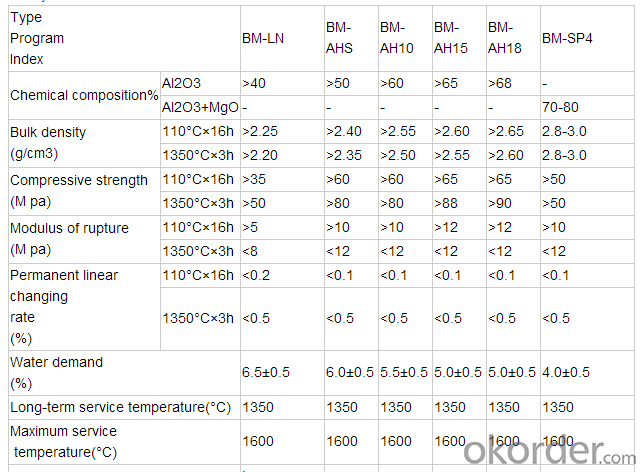
FAQ:
1. How you can control your quality?
For each production processing, we have complete QC system for the chemical composition
and Physical properties. After production, all the goods will be tested, and the quality certificate
will be shipped along with goods.
2. What's your delivery time?
It usually needs about 20days- 45 days after receiving the deposit.
3. Do you provide free samples?
Yes, we can provide a free sample for testing, If we have sample in stock,
The quantity based on the material type, The buyer should bear all the shipping costs.
4. What's your payment terms?
We can accept 30% deposit, 70% balance before shipment for ordrs over $ 2000.
5. Can we visit your Company?
Yes, certainly. You are very welcome to China and we will be honored to have a customer and friend.
Product Picture:
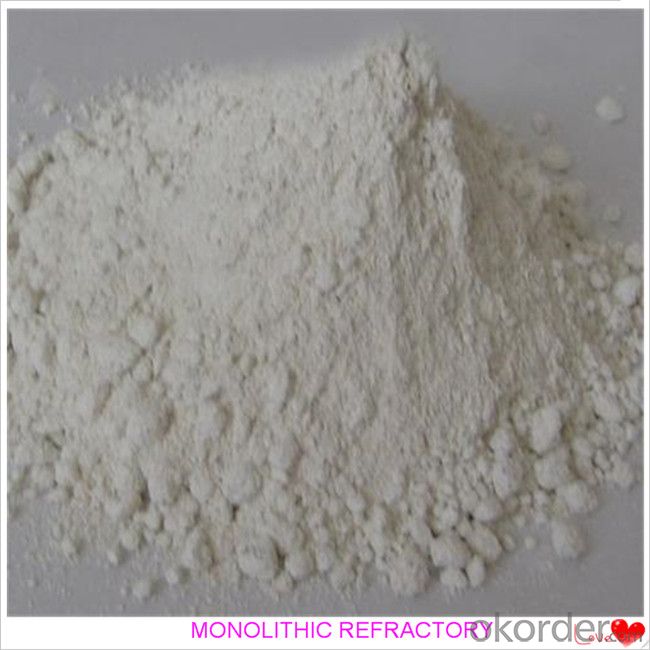
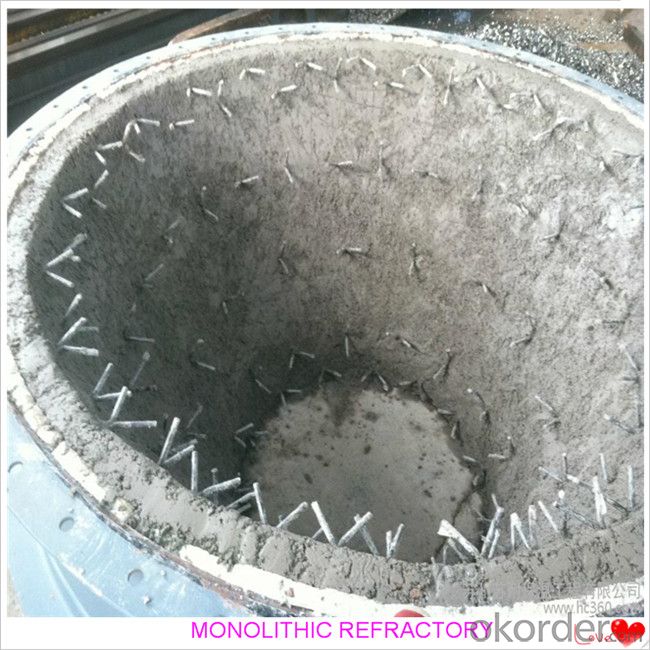
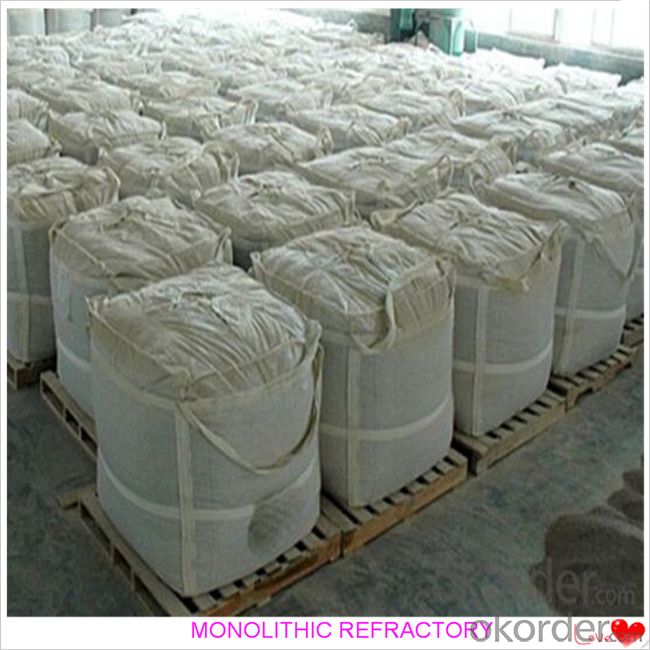

- Q: How does the composition of monolithic refractories impact their performance?
- Determining the performance of monolithic refractories is heavily influenced by their composition. These refractories are unshaped materials used to line furnaces, kilns, and other high-temperature equipment. Their installation convenience and ability to conform to complex shapes make them preferable over traditional brick and mortar refractories. Various components, such as aggregates, binders, and additives, constitute the composition of monolithic refractories. These constituents significantly impact the physical, mechanical, and thermal properties of the refractory material. Aggregates, which are the primary component, provide structural integrity to monolithic refractories. Alumina, silica, magnesia, and carbon are among the materials used for aggregates. Each aggregate possesses unique properties that determine the refractory's resistance to heat, chemical attack, and mechanical stress. For instance, alumina aggregates offer excellent resistance to high temperatures and chemical corrosion, while carbon-based aggregates have high thermal conductivity and are preferred for this reason. The addition of binders enhances the strength and cohesion of the refractory. Common binders include clay, calcium aluminate cement, and colloidal silica. The choice of binder depends on the desired strength, workability, and setting time of the refractory material. Additives are incorporated into the composition to improve specific properties. They can enhance the refractory's resistance to thermal shock, abrasion, or chemical attack. Additives like zirconium oxide, silicon carbide, and graphite are frequently used to enhance the performance of monolithic refractories in specific applications. The proper combination and proportion of these constituents are vital for achieving the desired performance of monolithic refractories. The composition affects the refractory's thermal conductivity, thermal expansion, density, porosity, and chemical resistance. For example, a higher alumina content improves resistance to high temperatures and chemical corrosion, while a higher silica content enhances insulation properties. In conclusion, the performance of monolithic refractories is significantly impacted by their composition. Careful consideration must be given to the selection of aggregates, binders, and additives to achieve desired properties and ensure optimal performance in specific high-temperature applications.
- Q: What are the advantages of using castables in the iron and steel industry?
- Using castables in the iron and steel industry offers several benefits. Firstly, castables have superb thermal insulation properties, which effectively maintain the temperature of the molten metal. This prevents heat loss and ensures efficient energy usage, resulting in cost savings. Additionally, castables exhibit exceptional refractory strength, enabling them to withstand extreme temperatures and harsh operating conditions. This durability prolongs the lifespan of the refractory lining, reducing the need for frequent repairs or replacements. Castables also offer versatility as they can be easily molded into various shapes and sizes, making them highly adaptable for different applications in the iron and steel industry. This flexibility allows for customization in designing the refractory lining to meet specific requirements. Furthermore, castables can be installed quickly and effortlessly, minimizing downtime during installation or maintenance. Their monolithic lining capability eliminates the need for individual bricks or tiles, saving time and effort. Castables are also resistant to chemical attacks from molten metal, slag, and other corrosive substances commonly encountered in the iron and steel industry. This ensures the integrity of the refractory lining and prevents contamination of the metal being processed. Moreover, castables typically require fewer raw materials compared to traditional refractory bricks or tiles, leading to cost savings in terms of material procurement, transportation, and storage. This makes castables a cost-effective solution. Lastly, the use of castables in the iron and steel industry enhances production efficiency by providing a smooth and uniform lining. This facilitates improved heat transfer, metal flow, and reduced downtime, ultimately increasing overall productivity. In conclusion, the advantages of using castables in the iron and steel industry encompass excellent thermal insulation, high refractory strength, versatility, easy installation, resistance to chemical attack, reduced material costs, and enhanced production efficiency. These benefits establish castables as the preferred choice for lining furnaces, ladles, tundishes, and other equipment in the iron and steel manufacturing process.
- Q: What are the advancements in monolithic refractory technology for the iron and steel industry?
- There have been significant advancements in monolithic refractory technology for the iron and steel industry in recent years. Monolithic refractories are a type of heat-resistant material used to line the walls and floors of high-temperature industrial processes, such as those involved in iron and steel production. One of the key advancements in monolithic refractory technology is the development of new and improved materials. Traditional refractory materials, such as firebricks, have been replaced by more advanced materials like castables and gunning mixes. These new materials offer superior performance in terms of thermal conductivity, thermal shock resistance, and erosion resistance. They can withstand higher temperatures and can be applied more efficiently, resulting in improved process efficiency and reduced downtime for maintenance. Another important advancement is the use of advanced additives in monolithic refractories. These additives can enhance the properties of the refractory material, such as increasing its resistance to corrosion and erosion. They can also improve the bond between the refractory and the substrate, ensuring a longer lifespan for the lining. Furthermore, advancements in monolithic refractory technology have led to the development of innovative installation techniques. For instance, shotcreting, a process that involves spraying the refractory material onto the surface, has gained popularity due to its efficiency and ability to provide a uniform lining. Similarly, the use of gunning machines, which pump the refractory material at high velocity, has improved the speed and accuracy of installation. Moreover, there have been advancements in the design of monolithic refractories specifically tailored for different applications in the iron and steel industry. Refractories for blast furnaces, ladles, tundishes, and other critical equipment have been optimized to withstand the unique challenges and harsh conditions of these processes. The development of specialized monolithic refractories has resulted in increased productivity, reduced energy consumption, and improved product quality in the iron and steel industry. In conclusion, advancements in monolithic refractory technology for the iron and steel industry have brought about improved materials, advanced additives, innovative installation techniques, and specialized designs. These advancements have significantly enhanced the performance, durability, and efficiency of refractory linings in high-temperature industrial processes. As a result, the iron and steel industry can benefit from increased productivity, reduced downtime, and improved product quality.
- Q: How do monolithic refractories contribute to the overall productivity of iron and steel production?
- Monolithic refractories play a crucial role in enhancing the overall productivity of iron and steel production. These refractories are widely used in various applications such as furnaces, ladles, and tundishes, offering excellent thermal stability and resistance to chemical attacks. By providing a durable lining, monolithic refractories ensure longer campaigns and reduced downtime for repairs and maintenance. This leads to increased production efficiency, reduced energy consumption, and improved product quality, ultimately contributing to the overall productivity of iron and steel production.
- Q: Can monolithic refractories be used in electric arc furnaces and induction furnaces?
- Yes, monolithic refractories can be used in both electric arc furnaces and induction furnaces. Monolithic refractories are versatile and can be shaped and installed easily, making them suitable for various types of furnaces, including electric arc furnaces and induction furnaces. These refractories are composed of a single material, such as castables, gunning mixes, ramming mixes, and plastic refractories, which can withstand high temperatures and thermal shock. They are commonly used to line the walls, roofs, and bottoms of furnaces to provide insulation and protection against the extreme heat generated during the melting and refining processes. Monolithic refractories offer excellent resistance to chemical attack, erosion, and mechanical stress, making them ideal for use in electric arc furnaces and induction furnaces, where intense heat and harsh operating conditions are encountered.
- Q: What are the key innovations in monolithic refractories for the iron and steel industry?
- The iron and steel industry heavily relies on monolithic refractories, which serve as lining materials in various high-temperature processes like blast furnaces, ladles, and converters. Over time, the field of monolithic refractories has witnessed several crucial innovations that address specific challenges and enhance the overall performance of these linings. Among the significant innovations in monolithic refractories is the emergence of low cement and ultra-low cement castables. These castables contain reduced cement quantities, resulting in improved properties such as higher hot strength, better thermal shock resistance, and enhanced resistance to chemical attack. By decreasing the cement content, the refractory achieves higher density, reduced porosity, and increased mechanical strength, ultimately leading to improved durability and extended service life. Another innovation in monolithic refractories is the introduction of self-flowing castables. These castables are designed to exhibit excellent flowability and can be conveniently installed through pouring or pumping, eliminating the need for manual vibration. Self-flowing castables offer advantages like reduced installation time, improved lining quality, and enhanced performance in complex geometries or hard-to-reach areas. In recent years, advances in nanotechnology have also influenced the development of monolithic refractories. Refractory compositions now incorporate nanoparticles, such as nano-sized additives and binders, to enhance their properties. These nanoparticles enhance the refractory's mechanical strength, thermal conductivity, and corrosion resistance. Additionally, nanotechnology enables better control over refractories' microstructure, resulting in optimized performance and increased lifespan. The development of high-performance monolithic refractories has also been driven by the need for improved energy efficiency and reduced environmental impact. Insulating castables, for instance, have been created to provide excellent thermal insulation properties, leading to reduced heat loss and energy consumption in various applications. These refractories contribute to increased energy efficiency, lowered production costs, and minimized greenhouse gas emissions. Moreover, advanced installation techniques like gunning and shotcreting have revolutionized the application of monolithic refractories. These techniques enable faster and more precise installation, reducing downtime and improving productivity. Additionally, robotic application systems have been introduced, allowing for automated and consistent refractory installation, ensuring high-quality linings with minimal human intervention. In conclusion, key innovations in monolithic refractories for the iron and steel industry encompass the development of low cement and ultra-low cement castables, self-flowing castables, the incorporation of nanotechnology, the introduction of high-performance insulation materials, and advancements in installation techniques. These innovations have significantly enhanced the performance, durability, energy efficiency, and installation processes of monolithic refractories, thereby contributing to the overall efficiency and competitiveness of the iron and steel industry.
- Q: How do monolithic refractories withstand thermal shock?
- Monolithic refractories possess unique properties and composition that enable them to endure thermal shock. Thermal shock occurs when there is a sudden alteration in temperature, leading to stress and potential damage to the refractory material. However, monolithic refractories are constructed to possess high resistance to thermal shock, and this is accomplished through various mechanisms. Firstly, the composition of monolithic refractories incorporates materials with low coefficients of thermal expansion. This implies that they undergo minimal alterations in size or volume when exposed to varying temperatures. This characteristic allows the refractory material to withstand thermal shock by minimizing the stress caused by temperature fluctuations. Secondly, monolithic refractories exhibit exceptional thermal conductivity. This quality enables them to efficiently transfer heat away from the hot regions, preventing localized overheating and diminishing the likelihood of thermal shock. The rapid dissipation of heat aids in maintaining a more even distribution of temperature within the refractory material, thereby reducing the chances of cracking or spalling. Furthermore, the binding agents employed in monolithic refractories play a vital role in enhancing their resistance to thermal shock. These binders provide strength to the refractory material and assist in preserving its integrity during thermal cycling. Additionally, the binders contribute to the refractory's ability to withstand thermal shock by reducing the permeability of the material, thus preventing the infiltration of hot gases or liquids that could cause damage. Moreover, the installation technique of monolithic refractories plays a significant role in their capacity to endure thermal shock. Typically, monolithic refractories are applied as a single, uninterrupted layer, eliminating the weak points such as joints and seams that exist in other refractory systems. This seamless installation method ensures superior resistance to thermal shock as there are no vulnerable points for cracks to propagate. In conclusion, monolithic refractories effectively withstand thermal shock through a combination of factors including their low coefficients of thermal expansion, high thermal conductivity, appropriate binding agents, and seamless installation techniques. These properties and design considerations enable monolithic refractories to proficiently handle rapid temperature changes and maintain their structural integrity, making them ideal for applications involving thermal cycling and extreme variations in temperature.
- Q: How do monolithic refractories contribute to the overall efficiency of ladle cleaning operations?
- Monolithic refractories play a crucial role in enhancing the overall efficiency of ladle cleaning operations. These refractory materials, which are composed of a single, homogeneous structure, offer several key advantages that contribute to improved efficiency. Firstly, monolithic refractories have excellent thermal insulation properties. This means they can withstand high temperatures without cracking or deteriorating, allowing for more efficient and effective ladle cleaning operations. By maintaining a consistent temperature, these refractories minimize heat loss and ensure that the cleaning process can be carried out without interruptions or delays. Secondly, monolithic refractories have high resistance to chemical attacks. Ladles used in steelmaking processes often come into contact with aggressive molten metals and slag, which can erode and corrode the refractory lining. However, monolithic refractories are specifically designed to withstand these harsh conditions, ensuring a longer service life and reducing the need for frequent repairs or replacements. This not only saves time but also reduces the overall cost of ladle maintenance. Furthermore, monolithic refractories have excellent flowability and workability. They can be easily shaped and installed in the ladle lining, allowing for quick and precise application. This ease of installation translates into shorter downtime during ladle cleaning operations, as the refractory lining can be repaired or replaced swiftly. Additionally, the flowability of monolithic refractories enables better coverage and adherence to the ladle's surface, ensuring that no gaps or weak points are left behind. This enhances the overall effectiveness of the cleaning process and prevents any potential contamination or reactivity issues. In conclusion, monolithic refractories contribute to the overall efficiency of ladle cleaning operations by providing excellent thermal insulation, high resistance to chemical attacks, and easy workability. These properties result in reduced downtime, increased durability, and cost savings, making monolithic refractories a vital component in optimizing ladle cleaning processes.
- Q: How are monolithic refractories installed and repaired in iron and steel production facilities?
- Monolithic refractories are vital components in iron and steel production facilities, as they provide insulation and protection against high temperatures, chemical corrosion, and mechanical wear. The installation and repair processes for monolithic refractories in these facilities require careful planning, expertise, and adherence to safety protocols. When installing monolithic refractories, the first step is to prepare the surface by removing any loose material and cleaning the area thoroughly. This ensures proper adhesion of the refractory material. The surface may also need to be roughened or textured to improve bonding. Next, the monolithic refractory material is mixed with water or a binder to create a workable consistency. It is then applied to the prepared surface using various methods such as casting, gunning, ramming, or troweling. The choice of application method depends on factors such as the type of refractory material, the area being repaired, and the desired outcome. During installation, it is essential to carefully follow the manufacturer's instructions regarding mixing ratios, curing times, and drying temperatures. Improper installation can lead to reduced refractory performance, premature failure, and safety hazards. Repairing monolithic refractories in iron and steel production facilities is an ongoing process due to the harsh operating conditions and mechanical stresses they endure. When a refractory lining shows signs of damage or wear, it is crucial to address the issue promptly to prevent further deterioration. The first step in repairing monolithic refractories is to assess the extent of the damage. This can be done through visual inspection, thermal imaging, or non-destructive testing techniques. Once the damage is identified, the repair method can be determined. Minor repairs can often be carried out using patching materials. These materials are typically the same or similar to the original refractory composition and are mixed with water or a binder to form a paste. The paste is then applied to the damaged area and allowed to cure. For more extensive repairs, the damaged refractory material may need to be removed entirely. This can be done through mechanical methods such as chipping, grinding, or cutting. After the damaged material is removed, the surface is prepared as mentioned earlier, and new refractory material is installed using the appropriate application method. It is important to note that the repair process should be conducted by trained personnel with expertise in refractory installation and repair. Safety precautions such as wearing protective clothing, using proper tools, and following established procedures should always be observed. In conclusion, the installation and repair of monolithic refractories in iron and steel production facilities require careful planning, adherence to manufacturer's instructions, and expertise in refractory materials. By following proper procedures and promptly addressing any damage, these facilities can ensure the longevity and efficiency of their refractory linings, ultimately contributing to the smooth operation of their production processes.
- Q: What are the common challenges faced by monolithic refractories in the iron and steel industry?
- Some common challenges faced by monolithic refractories in the iron and steel industry include thermal shock resistance, erosion and abrasion resistance, chemical corrosion resistance, and the ability to withstand high temperatures and thermal cycling. These challenges arise due to the harsh operating conditions, such as extreme heat, rapid temperature changes, and exposure to corrosive chemicals, which can cause damage and reduce the lifespan of refractory materials.
Send your message to us
Monolithic Refractories for Iron and Steel Industry - Fireclay Castable for Fireplace and Industrial Furnace
- Loading Port:
- China main port
- Payment Terms:
- TT OR LC
- Min Order Qty:
- 1000 kg
- Supply Capability:
- 3000000 kg/month
OKorder Service Pledge
OKorder Financial Service
Similar products
Hot products
Hot Searches
Related keywords
